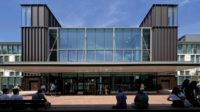A Prague Stairwell's DNA Structure Revealed

A Prague Stairwell's DNA Structure Revealed
The anti-slip grid of the glass landings (above) is arranged in the manner of the output from a DNA sequence registration machine.
Photo © Filip Slapal

A Prague Stairwell's DNA Structure Revealed
Photo © Filip Slapal

A Prague Stairwell's DNA Structure Revealed
The stairwell's stainless-steel wires (above) run the full length of the building and are held in tension to support the stair's structure. This is especially evident in the bird's-eye view below.
Photo © Filip Slapal

A Prague Stairwell's DNA Structure Revealed
Photo © Filip Slapal

A Prague Stairwell's DNA Structure Revealed

A Prague Stairwell's DNA Structure Revealed






Post a comment to this article
Report Abusive Comment